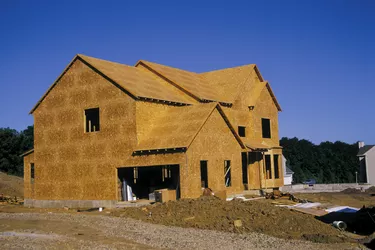
There are too many variables in construction costs to make it possible to provide a specific amount you'll need to build a house, but a brief survey of housing costs in three geographic areas will begin to give you an idea of the range. Considering other factors, such as lot and house size, brings you closer to a useful answer. While many cost factors are beyond your control, others are not. Early and careful planning will make your building experience more affordable and less stressful.
Factors Influencing Costs
Video of the Day
The cost of building a new house depends on many variables:
Video of the Day
• the geographical region you're building in: labor costs more in big cities and on the coasts; • land costs in your area: higher on coasts and lower inland; • whether you'll use a contractor or build it yourself, which also depends upon your experience and skill level • whether the lot is relatively flat or on a hillside; hillside buildings cost more • the geology of the hillside; geological strata slanting downhill requires more caissons (pilings) than strata slanting uphill; rocky sites also cost more • the square footage as well as the modesty or ambition of your architectural aims, • the stringency of building inspections in your area;
• your credit rating and access to financing and • whether or not the house is in a hurricane, flood or earthquake zone, which can increase costs by as much as 50 percent.
More factors could be listed, but the above are of greatest consequence.
The Nonexistent Average
The National Association of Home Builders conducts annual surveys of construction costs. The most recent indicates that for 2013 the average cost of residential home construction was $246,453. But this doesn't tell you what it will cost to build in your area. A Los Angeles Times survey for 2014 shows that Southern California new home construction costs averaged $516,500, twice the average. In Broward County, Florida, two 2014 estimates of mid-priced homes came in around $313,000. In New Mexico, a similar house cost $142,638.
In general, it costs more to build on the coasts or in desirable retirement or recreation areas, less elsewhere, more in states with relatively strong unions, less in right-to-work states.
Do not assume that resale housing prices and new construction closely correlate. As of the writing of this article, you can buy a 3 bedroom house in reasonably good condition in Detroit for under $60,000. Building a similar house would approximate or exceed the 2013 national new construction average of $246,453.
Controlling Costs
When resources are limited, consider building a smaller house on flat land and hiring a designer with a good reputation rather than an architect to produce your building plans. Make her aware that keeping down costs is important.
Get competing estimates from contractors, but only select one with many good references that check out. Some shady contractors give low bids, then walk with your money.
Control the construction budget. Often contractors have a favorite supplier with high prices. In most cases, the big box home building stores have the lowest materials prices.
Getting a Loan
When your resources are limited, Fannie Mae, the privately-held housing finance corporation with government oversight, can provide valuable assistance. Where the borrower does not own the building lot, Fannie Mae usually requires the borrower to contribute 30 percent of the combined cost of lot and construction. They also stipulate a minimum credit rating, which at the time of writing was 700. You apply for a Fannie construction loan or combined interim construction loan and the permanent financing through your lender.